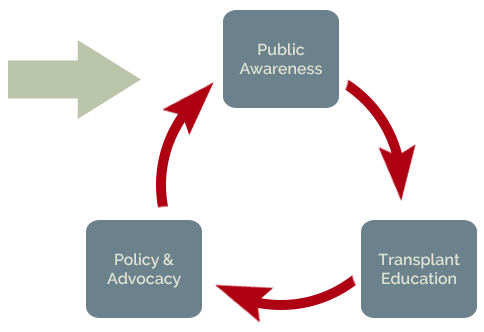Our Plan
Complex Crises Require a Comprehensive ApproachWhile there are scattered clinical efforts underway to increase living donation in the United States, there is not a comprehensive effort to educate the general public about living donation. Specialized transplant education is not offered to kidney patients and their loved ones as a matter of course. Although hundreds of millions of dollars are spent each year procuring deceased donor organs, outside of transplant centers only a few million are spent finding living donors.
Our Strategies
Waitlist Zero’s pursues three mutually-reinforcing strategies:
Taken together, these strategies aim to achieve policies within five years that will ultimately double the number of transplants from living donors. In collaboration with partners, WaitList Zero will pilot state-level change and refine it into a scalable national model and building momentum towards profound, shortage-ending change.
WaitList Zero’s Theory of Change
Problem
There is a chronic shortage of kidneys. Over 100,000 people are waiting for a life-saving kidney transplant. Waitlist growth is rapidly accelerating.
Dialysis is not a long-term solution. 450,000 Americans are on dialysis. Half will die within three years.
Living kidney donation has declined. Living donations have declined by 20% nationally since 2005.
As the crisis expands, so do the costs. Kidney disease costs taxpayers more than $350 billion a year. Dialysis treatment is three times more expensive than transplantation.
Solution

Programming
There is currently no comprehensive model in the United States to address the chronic shortage of kidneys that will continue to worsen over time. Increasing living kidney donation is the only real solution to addressing the shortage. Deceased donation alone will never be enough.
Policy and Advocacy
Pass “transplant support laws” in pilot states of Maine and New York to reduce barriers and increase protections to living donations; advocate for HRSA policy changes that support increases in living donation; advocate for systems-level changes at hospitals to convert more qualified living donations into actual living donors.
Public Awareness
Launch public awareness campaigns piloted in Maine and New York City to create a model to be scaled across the nation to educate the public about the kidney crisis and living donation; campaign especially targets those most at risk for CKD (i.e., African-Americans, Hispanics, and those over age 50).
Transplant Education
Design and implement culturally appropriate home- and community-based interactive education programs to educate patients and their families about transplant options and to support transplant candidates in finding a living donor.
These strategies aim to achieve policies within five years that will ultimately double the number of transplants from living donors.
